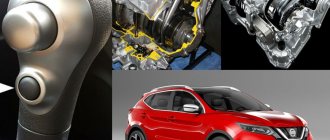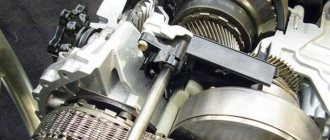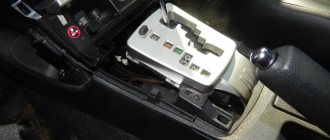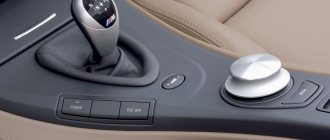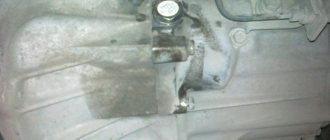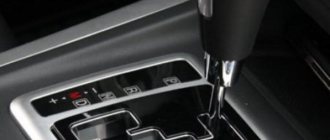The 2021 Toyota Rav 4 SUV is equipped with an independent suspension, a reliable transmission system, and an engine, resulting in rapid acceleration on the roadway. Ground clearance allows you to overcome road irregularities.
- mechanical,
- automatic,
- variable speed drive.
Each of these gearboxes has its own advantageous features. When purchasing this foreign car, many novice motorists have a question: which is better to buy a Toyota Rav 4 with an automatic transmission or a CVT?
Toyota RAV4 2021 owner reviews
- Review
- Prices
- Characteristics
- Photo
- Video
- Reviews
All the disadvantages of Toyota RAV4 2020
➖ Audio system ➖ Small pockets and glove compartment ➖ Ergonomics ➖ Sound insulation
pros
➕ Design ➕ Suspension ➕ Cross-country ability
The advantages and disadvantages of the Toyota RAV4 2021 in the new body were identified based on reviews from real owners. More detailed pros and cons of the Toyota RAV4 2.0 and 2.5 with automatic, CVT, front-wheel drive and all-wheel drive can be found in the stories below.
Owner reviews
1. Road unevenness goes over with super comfort, large wheel rollers + body rigidity absorb all unevenness, a very comfortable ride on the sometimes broken Astrakhan roads;
2. Electronics, especially Cold-On. I stop at a traffic light or in a traffic jam, release the brake pedal - my leg rests, the car stops. You press the pedal, start moving, and move on. After about 10 minutes the function is turned off, but the car is switched to automatic handbrake;
3. LED headlights and taillights, conventional halogen foglights;
4. The buttons were wisely distributed across the panels, although they were placed under a small visor and in a certain position it is not visible whether it is on or not;
5. The trunk has become larger (but only slightly), many niches and compartments have appeared, especially under the trunk floor lid, where the stowage bag is located;
6. The bottom of the car has become flatter (there are now plastic boxes), the muffler no longer sticks out and does not steal ground clearance. On standard curbs (20 cm) - you can park without problems;
1. The 2-liter engine assumes a leisurely drive (for the city, of course, it is quite enough), spins up when accelerating up to 3-4 thousand rpm (although it spins up quickly and with a howling sound), sometimes a push is felt.
2. There is no illumination of the buttons for folding mirrors and unlocking doors, they never did - it’s very inconvenient. Moreover, all these buttons are located in a single panel on the driver's door and it is difficult to find the right one.
3. The glove compartment was made very small, an A4 sheet can hardly fit in there (everything was great and roomy in the previous body)! How so?!
4. Why did they make such a shallow pocket for things on the driver’s side - the phone doesn’t fit there completely, it already fell out once during an emergency braking!
5. Noise insulation of the engine compartment - no, the engine is right next to it somewhere!
6. They removed the hanging net in the rear trunk, but it was very convenient (small things didn’t roll around in the trunk, but now they do), and you can’t even buy this as an accessory. Absolutely no.
Video review
Almost brutal design, some say it looks like a Highlander, others like an Outlander, but I don’t care, the main thing is that it has moved away from the femininity of old generations.
The 2.5 engine does not give the hurricane dynamics that you expect, but confident overtaking on the highway is guaranteed. In the city I didn’t notice any difference with version 2.0.
Eight-speed automatic transmission. I expected a lot from this unit, but wow did not happen. The six-speed automatic on the Camry works much smoother, but I’ll see if it gets used to it, it’s adaptive after all.
All-wheel drive is wonderful, you can especially feel it on the highway. In general, the car, although vaguely, has begun to resemble a Lexus RX; it clings to the road very well and does not “goat.”
Ground clearance is 195 mm and this is enough for family use of the car. Fishing or hunting is not an option at all, but a dacha, easy mountain tourism - that’s it!
Consumption is stated at 7.2 liters, but I don’t have it. The running-in may have an effect, but I haven’t dropped below 11.0 liters yet. But I always remember the consumption of the old RX or Prado - it makes me feel a little better.
As a result, the manufacturer managed to bring this model into the segment of almost men's cars due to its design and internal ergonomics. The first days behind the wheel I even remembered the time I owned the Prado: the heavy steering wheel, the imaginary feeling of a “big” heavy car. Believe me, you will like it!
During the January holidays, my friend and I decided to do some cross-country rides. Fortunately, there wasn’t much snow this year, so we got where we planned.
Now about the all-wheel drive: it drives interestingly, you can’t turn it on forcibly, but it seems to always row with all wheels. Sometimes you drill somewhere, you back up, it’s rowing, even your ass is jumping up!
In the sand mode it allows you to slip, you can put the car sideways if you want, the stones + mud mode is the most passable, I didn’t notice the difference between “normal” and “snow”.
Compared to the X-Trail, the new RAV4 is no worse and is equally passable. I can’t say that we got there without problems, since there were places where we had to swing shovels, and Ix’s clutch disconnected three times due to overheating. Overall, I'm pleased. We drove like this for about 30 km.
I've driven quite a bit, so I'll briefly describe the main +/-.
+ No matter how the Shumka is vacuumed, the car is quite good in terms of acoustic comfort, you can’t say that it doesn’t exist at all, the floor is generally covered with a thick layer of some kind of thick rag material.
+ I haven’t accelerated much yet; I try not to even push it to 4,000 rpm, but the acceleration is quite comfortable and fast. It accelerates from 100 to 130 km/h without any problems.
+ The suspension absorbs all unevenness, does not shake in the car, and swallows potholes/joints.
+ Steers clearly on the road at any speed, I really liked it here too.
— Ergonomics of the steering wheel heating buttons (difficult to hit right away), the right row of buttons on the monitor (inconvenient to reach), adjusting the brightness of the panel backlight (it’s normal not to reach, adjustment by pressing, not by twisting).
— Buttons for controlling the lighting of the front seats on the ceiling - I don’t believe that a sane person could come up with such control.
— For some reason, the trunk does not always come off the button from the passenger compartment after stopping. I had to go out and poke from the street.
— The sound of acoustics. Well, it was necessary to offer this for such a price... My wife’s Kia Rio sounds just as bad. Suitable only for listening to radio, which is received with interference...
I am comparing two generations, because... I own two RAV4s. One in the fourth body - the 2021 “Comfort” restyle and the new one in the fifth “Prestige”. Both are all-wheel drive, two-liter with CVT. There are pros and cons.
Externally, the car looks very attractive, a greyhound, without dull features. Much better in real life than in the photo. I like the interior more than in the fourth; I no longer have to reach for the buttons for heating the seats and switching modes. Cool climate control knobs, convenient, but the mode buttons were made small; you need to aim to press them.
Multimedia is functionally no different, but in terms of bass it is very bad, mainly in the upper and mid frequencies. But I don't listen to music, so I don't care. Music lovers need to think something about this. But you can watch movies, although it doesn’t support all formats - I checked avi and mp4, they work.
The pockets in the doors have become smaller; the plastic half-shell won't fit. The extra small window in the door makes it neither cold nor hot. This review is neither better nor worse. The mirrors are shifted closer to the driver, for me it somehow makes no difference. There was no illumination of the buttons on the driver's door.
Noise insulation is no better and no worse than the previous one, the engine can be heard just as well, but the sound is rougher, but this is not very pleasant. The engine/variator combination works worse, there are subtle shocks when switching. If you ride the fourth Rafa like you’re riding a trolleybus, then there’s no such thing here. Or you need to keep the speed from 3,000 and above, then the switching is not audible.
The average consumption according to BC shows 9 liters. When overtaking, it accelerates well, it presses into the back, but if at the moment of acceleration I turn the steering wheel into the next lane, then I get the feeling that the car is losing traction and at that moment I have to catch the car and steer.
If I overtake simply along the way, uniformly accelerating while changing lanes, then this does not happen. In the fourth body it keeps the lane changes rooted to the spot. If someone talks about tires, I’ll say right away - the tires on both cars are from the same manufacturer.
The design and principle of operation of the Toyota Rav4 variator
The Toyota Rav 4 variator produced in 2011 and subsequent generations has a classic V-belt drive for this type. Accordingly, the system has two main shafts, clutches for shifting and changing the gear ratio, bearings that ensure the rotation of moving mechanical parts, cuffs and gaskets that serve for additional protection, a housing that contains the entire system, and a belt for transmitting torque.
During operation, one of the shafts is connected directly to the engine, the second serves to transfer torque to the wheels. When you press the gas or brake pedal, the number of revolutions of the crankshaft changes, and the torque changes accordingly. At this time, the shaft transmits the given moment to the belt, which is connected to another shaft (driven), thereby changing the gear ratio and the distribution of traction throughout the vehicle system. As the speed changes, the belt either stretches or contracts, thereby changing the ratio of gear ratios.
In fact, a variator, regardless of its structure and design, does not have clearly defined classic gears, which is why such a box is often called continuously variable. However, for owners, the effect of the absence of classic gears is not only unusual, but often also uncomfortable, so developers often introduce “virtual” gears into the system, which artificially create the effect of shifting gears up or down, as well as the ability to manually change gear ratios in the system. On the CVT Toyota Rav 4, regardless of generation, there are 6 “virtual” gears.
General information about automatic transmission on Toyota RAV4
Older cars of this model are equipped with 2 types of automatic transmissions - U760E and U660E, which have similar designs and interchangeable parts. Recently released cars are equipped with an 8-speed DirectShift-8AT automatic transmission. It is characterized by an extended power range and fast gear changes.
The manufacturer has introduced a new gear machining technology and clutch linings specially designed for a specific transmission.
Design and principle of operation
The classic automatic transmission is a torque converter, invented at the beginning of the 20th century. The design consists of 3 main units that perform the following functions:
- Fluid couplings working with a special fluid. The unit is responsible for transmitting torque from the power unit to the gearbox. The fluid coupling is located on the flywheel of the motor.
- Hydraulic control mechanism. The unit maintains the normal functioning of the planetary gearbox.
- Switch box. It is the main part of the automatic transmission, responsible for changing speeds. This element is often called a planetary box.
Automatic transmission works like this:
- When the engine starts, liquid is supplied to the hydraulic transformer and the pressure increases. The pump blades begin to move. The wheels and turbine remain stationary.
- When you switch the lever and press the accelerator pedal, the speed of rotation of the blades increases. The oil enters the reactor and then returns to the turbine. The efficiency of the latter increases.
- Torque is transmitted to the wheels. The car begins to move at the desired speed.
- When the car moves uphill, the reactor stops rotating, and the torque is transferred to the centrifugal pump. When the desired speed is reached, the gears in the planetary gearbox change.
- When the car brakes, the fluid pressure drops. The speed gradually decreases. After stopping the engine, the pressure reaches 0, starting the car from a push becomes impossible.
The operating principle of an automatic transmission.
Disadvantages of automatic transmission:
— Increases fuel consumption by 10-15%
— The dynamic and speed performance of the car deteriorates
— Often with automatic transmissions, especially not new ones, there are delays when changing gears, that is, the mechanism can think for a long time before shifting
- More expensive in price and service. As a rule, problems with automatic transmissions begin after a run of 150,000 kilometers. But some modern machines are actually durable and do not have this drawback.
A variator is a type of transmission that has no steps, that is, it has no speeds.
Such boxes always maintain the most optimal number of revolutions depending on the driving style. If you need power, there will be speeds at which the engine will produce optimal power. Or you need fuel economy, the variator will maintain the speed that you need, for example, to save fuel, depending on how you press the gas pedal. The CVT also has a tiptronic function, which essentially simulates gear shifting, that is, increasing or decreasing the speed.
It turns out the same as with an automatic transmission. There is a function similar to kick down: pressing the pedal to the floor, the speed increases sharply, providing maximum accelerating dynamics. Advantages of the CVT gearbox:
-No jerking when changing gears
-Efficiency. With smooth acceleration, a CVT is more economical than even a manual transmission
- Outperforms all other boxes in dynamics. That is, if you take 2 Toyota Rav 4 cars, but put different gearboxes on them, then the car on which the CVT is installed will be in front
Disadvantages of the CVT gearbox:
- Less durable than a regular machine. Toyota Rav 4 variator resource
100,000 kilometers - Expensive repairs. But many are not afraid of this, since a car with a CVT has excellent dynamic properties and efficiency
Advantages and disadvantages of a CVT gearbox
The positive aspects of the transmission are the following parameters:
- the driver does not feel the shocks and jerks that occur when changing gears on an automatic transmission;
- acceleration is smooth;
- silent;
- economical and environmentally friendly.
But there are also negative aspects of a CVT transmission:
- high cost of repairs;
- does not tolerate extreme conditions;
- expensive restoration;
- expensive components for CVT.
Despite the disadvantages, many car owners prefer the Rav 4 SUV with a CVT transmission.
Automatic transmissions, including CVTs, make the life of a car enthusiast much easier. Driving a vehicle is not particularly difficult. The automatic transmission and CVT help keep the car under control in any conditions. Each option has its pros and cons.
How to extend the operation of a continuously variable transmission?
The main disadvantage of the Toyota Rav 4 CVT is its service life. The manufacturer claims a service life of two hundred thousand kilometers.
In fact, reliability depends on operating conditions and modes of operation. For some drivers, the transmission lasts 300 thousand km, while for others it lasts less than a hundred. Expensive maintenance is also noted.
You can read more about maintenance (oil change and level checking) of the CVT Toyota Rav 4 here.
To maintain the reliability and smooth operation of the variator, you should adhere to the following recommendations:
- Periodically check the oil level and cleanliness .
- Perform preheating at subzero temperatures .
- Do not load the variator until reaches sixty degrees .
- Avoid overheating of the transmission mechanism, especially those that have served most of the resource declared by the manufacturer. To solve the problem, you will need to install an additional radiator.
- Do not pull other cars on a cable and do not tow the Rav 4.
- Adhere to posted speed limits.
- In accordance with technical recommendations and when primary signs of malfunction appear, change consumables .
Typical automatic transmission problems identified during operation
All automatic transmissions installed on Toyota RAV4 are, to one degree or another, sensitive to compliance with replacement intervals and oil quality. Still, the U660E and U760E gearboxes are most dependent on the timely change of lubricant. If you do not carry out their maintenance, repairs will not take long.
A feature of an automatic transmission is the difficulty of completely changing the lubricant yourself. Car owners usually repeat the oil drain/fill cycle several times to minimize the residual amount of fluid. Therefore, large containers with original transmission fluid are also available for sale.
The automatic transmission uses a felt filter with a double membrane. It is disposable. The service life of the filter element is in the range of 150-180 thousand km. However, it is better to replace it more often. Experienced car owners recommend installing a new filter element before each filling of fresh oil.
Rapid contamination of the lubricant or a burning smell from the oil indicates a critical condition of the clutches. They usually fail after a mileage of 150-200 thousand km. Driving style significantly affects the life of friction clutches. For car owners with a calm driving style, the U241E torque converter often lasts more than 500 thousand km.
Problems rarely occur with the mechanical part of the U140-U241 automatic transmission when driving up to a million km. However, with an aggressive driving style, the planetary gear may become damaged when the odometer shows 350-400 thousand km. The axes of the satellite gears often break due to extreme loads. This leads to a reduction in the contact patch of the gears of the assembly, which significantly accelerates the destruction of the teeth. This process is most accelerated by oil starvation due to contamination of the lubricant.
Basic faults
Transmission problems do not always appear gradually. Therefore, if the variator breaks down, it can quickly lead to the inability to control the car.
CVT repair
What problems are typical for CVT and how to repair the box in a car with a 2-liter engine or another volume:
- Failure of the planetary gear set. When the unit operates under high load conditions, this leads to the destruction of the gear axes, and as a result, their teeth break. In this case, the teeth must be replaced.
- Oil starvation. In the absence of lubrication and the engine operating at high speeds, when the car is used off-road, damage to the planetary gear occurs. You can see such a malfunction when replacing the filter device. The magnets installed in the tray collect wear products in the form of metal shavings; you need to inspect them. If the vehicle's mileage is more than 150 thousand km, and the size of the steel chips is more than 1 mm, this indicates that a chain reaction of gear destruction occurs during the operation of the unit. If you do not take any action, the gearbox planetary gear may damage the pumping device and other components of the gearbox. In this case, repairs will be expensive.
- Front gear failure. When operating a vehicle in aggressive conditions, damage to this part occurs. The wear products of the element ultimately damage the ring gear. If you do not solve the problem in time, the presence of metal shavings can damage the rear planetary gearbox. As a result, the clutches will fail.
- With intensive use, especially in off-road conditions, rapid wear of the support bearing devices occurs. We are talking about parts located on the primary and secondary shafts. Fixing this problem is quite difficult, since you will not find bearings for Toyota CVTs on sale. CVT parts are not available on the aftermarket. Therefore, to solve the problem, you will have to look for bearings at a car disassembly or buy similar ones in size and turn them on a lathe to fit the dimensions of the installed parts. This repair option is considered the cheapest.
- Sensor failures. CVT transmissions are equipped with a large number of different electronic controllers designed to read data and transmit it to the control unit. The failure of one sensor can affect the functionality of the CVT as a whole. If the diagnostics show a failure of the controller, it is necessary to carry out a detailed check of it. It is necessary to check the connectors and contacts. Often the cause of malfunction lies in damage to the plug.
- Malfunctions in the operation of the control system. If the central processor fails, the transmission will not work. If the control module is malfunctioning, but is still functioning, the gearbox will work, but intermittently. It is better to entrust the solution to problems in the operation of the control unit to professionals. Sometimes it is necessary to reflash the unit, but it is almost impossible to do it at home.
- Broken drive belt. Due to rapid wear and improper use, the drive belt may break. Its links can scatter throughout the gearbox and damage other components of the variator.
Damage to the differential flange is especially dangerous. The drive for the so-called transfer transmission passes through a flange on the differential housing. This element has thin walls and in practice problems often occurred when the part burst due to operation under constant high loads. This leads to lubricant leakage. If it is not detected and resolved in a timely manner, the transmission fluid may completely drain from the box. In addition, the flange will crumble in the system and its fragments will fall on the gears of the transmission, which will lead to damage to transmission parts. The difficulty of repair lies in the fact that differentials for CVT gearboxes cannot be found on sale.
Possible breakdowns with automatic and CVT gearboxes
When operating a CVT transmission, the following problems may arise:
- Damage to the side plates due to oil contamination;
- filter clogging, which contributes to a decrease in operating pressure in the unit, uncoordinated rotation of shafts, belt rupture, and slippage;
- moisture ingress during washing;
- overheating, leading to destruction of the belt and pulleys.
On a car with a CVT transmission, the owner may encounter problems with moisture ingress.
The automatic transmission works properly up to 1 million km. During aggressive driving, the planetary gear is damaged after 400 thousand km. Increased loads contribute to the occurrence of such malfunctions:
- destruction of the axes of adjacent gears, leading to a reduction in the contact spot;
- damage to the pump by large abrasive particles;
- oil leakage caused by wear of gaskets and seals;
- breakdown of the pump bushing resulting from driving with contaminated oil;
- clogging of solenoids with torque converter destruction products;
- bearing failures.
Is it worth buying a new Toyota RAV4 2021: owner reviews, all the disadvantages, options and prices
How much does the new Toyota RAV 4 2021 cost in Russia: on the official dealer’s website, the price of the car varies from 1,852,500 to 2,764,500 rubles . The crossover is offered in four different trim levels: Standard, Comfort, Prestige and Prestige Safety.
The 2021 Toyota RAV4 powertrain line for our market is represented by 2.0- and 2.5-liter gasoline engines. Three transmissions are offered at once: the most affordable version has a six-speed manual, and the rest are equipped with either a stepless variator or an eight-speed automatic. The base crossover has front-wheel drive, but the more powerful variant comes with all-wheel drive.
Options and prices Toyota RAV4 2020
| Equipment | Price |
| 2.0 (149 hp) Standard MT6 | 1 852 500 |
| 2.0 (149 hp) Comfort CVT | 2 076 500 |
| 2.0 (149 hp) Comfort 4WD CVT | 2 182 500 |
| 2.5 (199 hp) Comfort 4WD AT8 | 2 383 500 |
| 2.0 (149 hp) Prestige 4WD CVT | 2 386 500 |
| 2.0 (199 hp) Prestige Safety 4WD CVT | 2 563 500 |
| 2.5 (199 hp) Prestige 4WD AT8 | 2 587 500 |
| 2.5 (199 hp) Prestige Safety 4WD AT8 | 2 764 500 |
MT6 - 6-speed manual, AT8 - 8-speed automatic, CVT - variator, 4WD - all-wheel drive
- “Standard” configuration, the crossover is equipped with 17-inch alloy wheels, 7 airbags, ABS and ESP, an audio system, an on-board computer, a tire pressure sensor, a light sensor, air conditioning, a multimedia system with a 7.0-inch touch screen, front and rear rear power windows, heated seats and steering wheel, fog lights, LED headlights, hill start assist, fabric upholstery, and electrically adjustable heated mirrors.
- Comfort version additionally has a rain sensor, push-button engine start, a rear view camera with parking sensors, climate control, passive cruise control and an electric trunk. Plus, this car comes with 18-inch alloy wheels and an 8.0-inch multimedia display, while all-wheel drive versions are equipped with a hill descent assist system.
- The crossover in the pre-top version “Prestige” is installed on 19-inch wheels, and the list of its equipment has been expanded to include a leather interior and electric front seats with memory settings.
- “Prestige Safety” package also sports adaptive cruise control, adaptive headlights, blind spot monitoring and standard navigation.
Pros and cons of Toyota RAV4 5th generation
+ Pros
- Design
- Suspension
- Spacious salon
- Minuses
- Music
- Controllability
- Ergonomics
Reviews from owners of Toyota RAV4 2019-2020
The car has become wider, which also affects the comfort in the cabin. Now I can’t even get my bag out of the back seat, although the length of the car has decreased a little, but for some reason the interior has increased in both width and length.
I like the trim on the side doors - unusual, but it looks good. The seats have been slightly modified and have curved sides, which provides additional comfort when driving - on the old Rafik, pain began in the back and in the cervical region during a long drive, but in the new one there are no such sensations yet, since the seats seem to hold the back in a comfortable position.
Review of Toyota RAV4 2.0 (149 hp) CVT 4WD 2021
When overtaking, it accelerates well, it presses into the back, but if at the moment of acceleration I turn the steering wheel into the next lane, it feels like the car is losing traction, and at that moment I have to catch the car and steer. If I overtake simply along the way, uniformly accelerating while changing lanes, then this does not happen.
In this regard, the RAF in the previous body keeps the lane in its tracks. If someone talks about tires, then they are from the same manufacturer on both cars.
Dmitry, review of the 2021 Toyota RAV 4 2.0 CVT 4WD
The car has an almost brutal design, some say it looks like a Highlander, others like an Outlander - I don’t care, the main thing is that it has moved away from the femininity of the old generations, in any case it’s catchy. It has not increased in size, although it looks larger than its predecessor. There are features of American cars, it seems like the appearance was developed there.
Review of Toyota RAV 4 2.5 with automatic transmission and all-wheel drive, 2020.
The 2.0-liter engine assumes a leisurely ride (for the city, of course, it is quite enough), spins up when accelerating to 3-4 thousand rpm (though it spins up quickly and with a howling sound). When starting to move (when going beyond 15 km/h), a push is felt in the CVT gearbox - this was not the case on the previous model. Sometimes the same effect is felt with a sharp increase in speed (again, this did not happen before).
Review of Toyota RAV4 2.0 with CVT and all-wheel drive 2019
The ergonomics of the cabin were disappointing. The steering wheel heating buttons are difficult to hit right away, and the right row of keys on the monitor is difficult to reach. The front seat lighting control buttons are actually located on the ceiling - I don’t believe that a sane person could come up with such a control. The rear passengers are illuminated in the position of the head (the light falls inconveniently).
The sound of the acoustics... It was necessary to offer this for such a price... My wife's Kia Rio sounds just as bad. It is only suitable for listening to the radio, although even here it is received with interference.
Review of the new Toyota RAV 4 2.5 (199 hp) automatic transmission 4WD 2021
I don’t advise anyone planning to change from a “German” to a “Japanese” one. At the moment I can't get used to it. Claimed fuel consumption is 10 liters. I don’t know why, but I have 13.9 liters. Of course, I don’t drive like a pensioner, but I also don’t press the pedal to the cutoff point. If compared with the Tiguan, then heaven and earth - the “Japanese” is uncontrollable. At 140 km/h you get the feeling that you no longer own the car - the steering wheel is empty.
Artem, review of Toyota RAV4 2.5 AT 4WD 2021.
Specifications
The new body of the new generation Toyota RAV 4 2021 is based on the TNGA K platform, while high-strength steel grades are actively used in its power structure.
The car also boasts a fully independent suspension with transverse stabilizers: MacPherson struts are installed at the front, and a multi-link arrangement is used at the rear. All wheels of the SUV are equipped with disc brakes, but they are also ventilated at the front.
Interestingly, the basic 4WD versions use an all-wheel drive transmission with a clutch to connect the rear axle, while the most expensive versions rely on. The latter is characterized by the presence of two individual clutches on the rear wheels, which allowed the Japanese to implement thrust vector control.
The Toyota RAV4 V generation crossover has the following overall dimensions, mm
- Length - 4 600
- Width - 1,855
- Height - 1,685-1,690
- Wheelbase - 2,690
- Ground clearance (clearance) - 195
The model’s trunk volume is 580 liters, while the capacity of the “hold” with the rear row seats folded is 1,690 liters. Without exception, all versions of the Rafik are equipped with a 55-liter fuel tank. As for the curb weight, according to the data sheet it varies from 1,570 to 1,715 kg, directly depending on the specific modification and level of equipment.
- The all-terrain vehicle is equipped with a 2.0-liter gasoline unit with a capacity of 149 hp as the base engine. (206 Nm). It can work with both a six-speed manual and a CVT. Cars with manual transmission are exclusively front-wheel drive and are capable of accelerating from zero to hundreds in 9.8 seconds, reaching speeds of up to 190 km/h.
- The version with a CVT can be ordered with both front-wheel drive and all-wheel drive, but in both cases the RAV 4 will be able to accelerate from 0-100 km/h in 11.0 seconds (maximum speed is the same 190 km/h).
- More expensive versions of the new model are equipped with a 2.5-liter engine producing 199 horsepower and 243 Nm of torque. This motor works in tandem with an eight-speed automatic, and the drive is already in the base. This modification can accelerate to hundreds in 8.5 seconds, and its speed limit is 200 kilometers per hour.
How to distinguish an automatic transmission from a CVT
As a rule, before purchasing a car with an automatic transmission, the potential owner immediately decides for himself what is better, a regular automatic, a CVT or a robot. If we take into account the fact that the traditional hydromechanical automatic transmission, although not without its shortcomings, remains the most reliable and time-tested transmission among other automatic transmissions, it is not surprising that such a gearbox is in the greatest demand on the secondary market.
At the same time, versions with a CVT or robot, taking into account their weaknesses, are less in demand. Naturally, such machines are also cheaper compared to analogues. At the same time, sellers who do not want to reduce the price or for other reasons often try to pass off the robot as an automatic or CVT, a CVT as a traditional automatic transmission, etc.
Please note that often the initial knowledge of how to distinguish a CVT from an automatic by lever is simply not enough. The main reason is the deliberate replacement of the lever (selector) by the unscrupulous owner himself, tuning the lever using covers for the gearshift knob, reupholstering the selector with leather, etc.
So, in order to correctly determine the type of gearbox visually, you need to follow a certain procedure and take into account a number of recommendations. First of all, you should start with the following:
- Before inspecting the car, you need to collect as much information as possible regarding transmission options for a specific model on the Internet; you can also use technical literature, catalogs, etc.
- When inspecting, carefully study the documents for the car, as well as the marking plates on the body and components. As a rule, if the car is equipped with an automatic transmission, then this will be indicated by the letters A or AT. In the case of a variator, the designation CVT is used.
- When trying to visually identify it, you need to inspect the gearshift lever, since CVTs often have the CVT designation printed on them. You also need to pay attention to the modes near the gear selector. In the case of a conventional automatic, in addition to the standard PRND modes, you can also see modes “L”, “2”, sometimes “3”, while CVTs have only the “L” mode.
Please note that many modern automatic transmissions, like CVTs, may still not have such modes, that is, there are PRND and M modes (Tiptronic manual mode). This complicates the task somewhat. For this reason, the next stage of checks is to determine the type of automatic transmission in motion, that is, the operation of the transmission on the move is analyzed.
To do this, after starting the engine, you need to dynamically accelerate the car from a standstill in standard mode D. If during acceleration there is no clearly noticeable gear shift moment, and the engine operates monotonously at the same speed (the tachometer does not show first a set of revolutions, and then a decrease in speed when moving to a higher level), then this indicates that the car has a CVT.
In the case of an automatic transmission, acceleration will be similar to how a car with a manual transmission accelerates, that is, first the engine spins up (audible by the sound of the internal combustion engine and visible on the tachometer), after which it shifts to a higher gear, after which the speed drops. At the same time, it is important to actively accelerate the car, since with a calm start and a leisurely increase in speed, the automatic transmission and the variator can work almost identically.
You can also stop the car completely on a section of road with a slight incline. After this, you should release the brake pedal without adding gas. If the car starts to move slowly uphill at idle, this indicates that the car has an automatic transmission. If the car rolls back a little and then just stands there, this often indicates a CVT. However, such a check is only suitable if the car with a CVT does not have an additional “recoil” system.
Finally, we note that if you still cannot determine the type of automatic transmission on your own, then it is optimal to visit a service station, where qualified specialists will immediately answer your question and, if necessary, carry out a comprehensive diagnosis of the car.
Toyota with automatic transmission
For city residents, it is recommended to purchase a car with an automatic transmission. The peculiarity of this box is that the risk of overloading the power plant is reduced. The engine will operate at optimal speed. The entire driving process is controlled by an electronic system. This minimizes the risk of driver errors while driving.
Despite the listed advantageous features, a car with an automatic transmission does not save fuel consumption per km. It is possible that there will be delays in changing speed limits.
When comparing a Toyota Rav 4, which has a manual transmission, with a car equipped with an automatic transmission, the latter is more expensive to maintain. Depending on your driving style, the first problems with the automatic transmission may occur after 100,000 km.
CVT reliability and service life
The variator is sensitive to oil. It is necessary not only to strictly observe its replacement intervals, but also to purchase exclusively original transmission fluid.
It is important to accompany each lubricant change with the installation of a new filter element. Otherwise, there may be a drop in transmission fluid pressure and increased wear of components and parts.
With an active driving style, pulley shaft bearings fail at 60-80 thousand km. If they are not replaced, the cones wear out at an accelerated pace.
Review of feasibility of repairs
The boxes used on Toyota RAV 4 are very popular. The prevalence of transmissions has led to lower cost of parts. Therefore, repairs are almost always profitable. Purchasing a new or contract box is justified only in case of significant damage to the original unit.
Table - Estimated prices for new and used gearboxes
| Transmission type | Cost of a new unit, thousand rubles | Contract gearbox, thousand rubles |
| Automatic transmission | from 220 | 40-95 |
| Manual transmission | from 100 | 14-35 |
| Variable speed drive | from 250 | 50-100 |
Time for a change: Why is a Toyota RAV4 with a CVT better than an automatic?
Are the days of automatic transmission already over?
The new generation Toyota RAV4 has turned out to be a rather controversial crossover, which has many positive aspects, but also disadvantages. Together they create a double impression of this “Japanese”. What about the technical part?
Under the hood of the Toyota RAV4 there are two engines to choose from: a 2.0-liter unit that produces 149 horsepower and a 2.5-liter engine with 199 horsepower. The younger engine is paired with a manual transmission and a variator to choose from, while the older one is equipped only with an automatic transmission. Which transmission is better and why are the days of the “automatic” already gone?
Many note that the 2.0-liter Ravik moves more smoothly and pleasantly on the road, because the CVT does not have the sharpness of an automatic transmission, although sometimes this is also lacking. In addition, the engine is noticeably quieter, unlike a larger engine, which is also important for a comfortable ride.
It’s time for change - the automatic transmission is already beginning to give way to the once unloved and “terrible” transmission called the CVT. Many people still don’t like this type of gearbox, but in the new Toyota RAV4 it is extremely difficult to distinguish it from a classic “automatic”, because the Japanese have taught the continuously variable transmission to simulate gear shifts like on an “automatic”. Also, it is worth noting that on the highway, the Ravik with an automatic transmission has lower consumption, because at 80 km/h there are only 1500 engine revolutions.
Bloated Yeti or Tiguan "for the poor"? What will happen to the “basic” Skoda Karoq on the Russian market
Despite the negativity from the Russians, the cheapest Karok is quite good for the money.
Subscribe:
Review of gearboxes on Toyota RAV4 cars
Pre-restyling cars with a 2-liter engine were equipped with the U140 automatic transmission and its modifications U140E and U140F. On more powerful cars with a 2.4-liter engine, the U240, U240E, U241 and U241E series of automatic transmissions were used. A little later they were replaced by the U250E box. The latest generation of Toyota RAV4 comes with U660E and U760E automatic transmissions. All boxes have a similar design, so most of the components and parts are interchangeable.
The U140E box debuted in 1998. Its design turned out to be extremely successful. The safety margin of the automatic transmission is impressive. For 4x4 vehicles, the U140F modification was developed.

